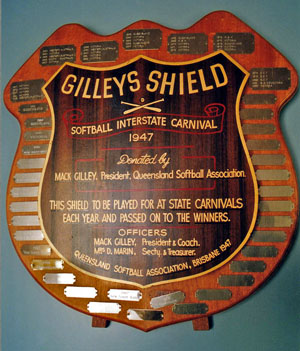Related Research Articles

The Gilleys Shield is a trophy symbolising the Open Women's Championship of the Softball Australia organisation. The competition's full name is the Mack Gilley Shield.

The Elinor McKenzie Shield is a trophy symbolizing the Under 18 Women's Championship of Softball Australia.
Softball in Australia is played in Australia.
Softball is played in Queensland .
Softball is played in New South Wales, introduced to the state in 1939. By 1984, there were 1,356 registered teams in New South Wales. Players from Australia have been on the men's and women's national team, had AIS scholarships, played at universities in the United States, and professionally in the US, Japan and Europe.
Softball is played in the Australian state of Victoria.
Softball is played in South Australia.
Softball is played in Western Australia.
Softball is played in the Australian Capital Territory. The game was influenced early in its history in the territory by Queanbeyan. There are efforts to increase participation in the sport in the ACT. The territory has won the Gilleys Shield three times in a row. Players from Canberra have been on the national team, held Australian Institute of Sport scholarships and played for American universities.
Softball is played in the Northern Territory, Australia.

The Australian Men's Softball Team is the national softball team of Australia. They are nicknamed the Aussie Steelers. The team is governed by Softball Australia and takes part in international softball competitions.
Zimbabwe men's national softball team is the national softball team for Zimbabwe. The 1988 World Championships were held in Saskatoon, Canada. The team played 13 games in the round robin round. Australia beat Zimbabwe 2–0 in one game in this round.
Chinese Taipei men's national softball team is the national team for Taiwan. The 1988 World Championships were held in Saskatoon, Canada. The team played 13 games in the round robin round. Australia beat Chinese Taipei 2–0 in one game in this round. The 1992 World Championships, the eighth time the event was competed for, was held in Manila. Australia beat Chinese Taipei 9–2 in one game in the first round robin round. They finished with 4 wins and 4 losses. The team competed at the 1996 ISF Men's World Championship in Midland, Michigan where they finished with 4 wins and 6 losses. The team competed at the 2000 ISF Men's World Championship in East London, Eastern Cape where they finished fifteenth.
Cuba men's national softball team represents Cuba in international softball competitions. The team played at the 1988 World Championships were held in Saskatoon, Canada. They played 13 games in a round robin tournament, and beat Australia 7–4 in one game.
Indonesia men's national softball team is the national team for Indonesia. The 1992 World Championships, the eighth time the event was competed for, was held in Manila. Australia beat Indonesia 5–4 in one game in the first round robin round. The team competed at the 2009 ISF Men's World Championship in Saskatoon, Saskatchewan where they finished sixteenth.
The Czechoslovakia men's national softball team made only one international appearance, in the 1992 World Championships in Manila. It had a record of 1-7 in the preliminary round-robin round and did not advance.
Singapore men's national softball team is the national team for Singapore.
Bahamas men's national softball team is the national team for Bahamas. The 1988 World Championships were held in Saskatoon, Canada. The team played 13 games in the round robin round. They finished sixth overall. The team competed at the 1996 ISF Men's World Championship in Midland, Michigan where they finished with 5 wins and 5 losses.
The British Virgin Islands men's national softball team is the national team for the British Virgin Islands. The 1988 World Championships were held in Saskatoon, Canada. The team played 13 games in the round robin round, finishing twelfth overall.
Bermuda men's national softball team is the national team for Bermuda. The 1988 World Championships were held in Saskatoon, Canada. The team played 13 games in the round robin round. They finished thirteenth overall.
References
- ↑ Embrey, Lynn; Australian Softball Federation (1995). "Hits and Bunts". Batter up! : the history of softball in Australia. Bayswater, Vic.: Australian Softball Federation. pp. 69–127.
- 1 2 3 4 5 6 Embrey, Lynn (1995). "Hits and Bunts: Tasmania". Batter up! : the history of softball in Australia. Bayswater, Vic.: Australian Softball Federation. pp. 33–35.
- 1 2 Pollard, Jack (1968). AMPOL book of Australian Sporting Records. Sydney: The Pollard Publishing Co. pp. 273–274. OCLC 71140.
- ↑ Vamplew, Wray; Australian Society for Sports History; Australian Sports Commission (1994). The Oxford companion to Australian sport (2 ed.). Melbourne: Oxford University Press. pp. 388–389. ISBN 0195532872. OCLC 27509815.
- ↑ Embrey, Lynn; Australian Softball Federation (1995). "Appendix H". Batter up! : the history of softball in Australia. Bayswater, Vic.: Australian Softball Federation. p. 170.
- ↑ "Softball: Softball Australia". A survey of cultural diversity and racism in Australian sport (PDF). Australia: Australian Human Rights Commission. p. 10. Retrieved 18 March 2012.
- ↑ Vamplew, Wray; Australian Society for Sports History; Australian Sports Commission (1994). The Oxford companion to Australian sport (2 ed.). Melbourne: Oxford University Press. p. 521. ISBN 0195532872. OCLC 27509815.
- ↑ "Sandra breaks through". Caboolture Shire Herald. Brisbane, Australia. 7 December 2004. p. 36. Retrieved 13 March 2012.
- ↑ Embrey, Lynn; Australian Softball Federation (1995). "Hits and Bunts". Batter up! : the history of softball in Australia. Bayswater, Vic.: Australian Softball Federation. pp. 69–127 [124].